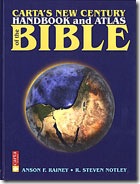Carta’s New Century Handbook and Atlas of the Bible has arrived at Eisenbrauns. Because this is a shorter version of The Sacred Bridge, it’s been dubbed by some as “The Sacred Abridgement.” The longer volume costs $100; the shorter is $50. The length though is more than half, and I’m sure there’s plenty of “bang for the buck.” I haven’t seen it, but based on the longer version, I’m sure that it will be a superb resource.
costs $100; the shorter is $50. The length though is more than half, and I’m sure there’s plenty of “bang for the buck.” I haven’t seen it, but based on the longer version, I’m sure that it will be a superb resource.
The publisher’s description says this:
The object of this concise version is to augment the personal Bible study of all who seek a straightforward understanding of biblical history. Nevertheless, the reader will still have the sense that sacred history came about in a real world, a realm illumined by a multitude of discoveries and studies during the past two hundred years. Furthermore, the geographical dimension of the Bible accounts is being thoroughly presented. Every Bible student may thus put himself in the ancient reality and feel the events as they were experienced by the ancient Israelites and their neighbors.
UPDATE (11/19): Author Anson Rainey told a friend of mine that the differences between the two editions are these:
1) Bibliography and in-text references removed in shorter edition
2) Original language texts removed but translations remain
3) Two chapters on Bronze Age reduced to one
4) Typographical errors corrected
Thus it seems that with CNCHAB you get about 80% of the content for 50% of the price.
